
Key Takeaways
- During World War II, about 1,000 Japanese soldiers were reportedly massacred by saltwater crocodiles on Ramree Island, Burma.
- Historians and experts doubt the veracity of the crocodile attack story, as no official military reports from either side confirm it, and the behavior of saltwater crocodiles does not support such a feeding frenzy.
- The real danger to the Japanese troops was likely the harsh conditions of the mangrove swamp and the intense military conflict with Allied forces, not a massive crocodile attack.
In early 1945, as part of the Pacific War during World War II, Allied forces pinned down 1,000 Japanese soldiers in a mangrove swamp off the coast of Burma (now Myanmar). Only 20 of the Japanese fighters made it out alive. The rest were reportedly eaten alive by hordes of prehistoric-looking saltwater crocodiles. According to one Allied commander:
This horrific event is known as the Ramree Island crocodile massacre, and in 1968 the Guinness Book of World Records awarded it the dubious distinction of "most human fatalities in a crocodile attack" at roughly 900 dead.
Advertisement
But in recent decades, historians and herpetologists have cast doubt on the ghastly tale. While it's clear that scores of Japanese soldiers died in the battle for Ramree Island, there's no mention of a "crocodile massacre" in official military reports (either British or Japanese), and saltwater crocodiles aren't known for "feeding frenzies" of this scale, especially on live human prey.
So where did this apocryphal tale come from, and how did it spread so far and wide?
Advertisement



